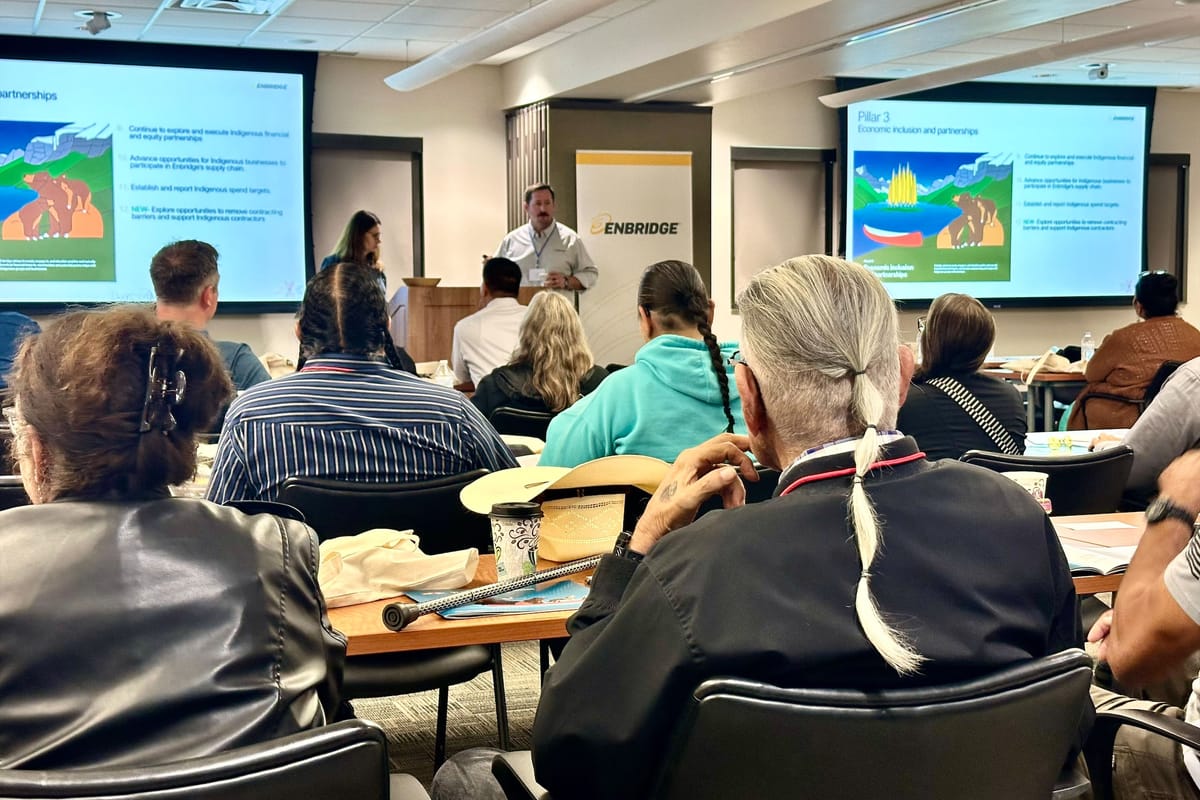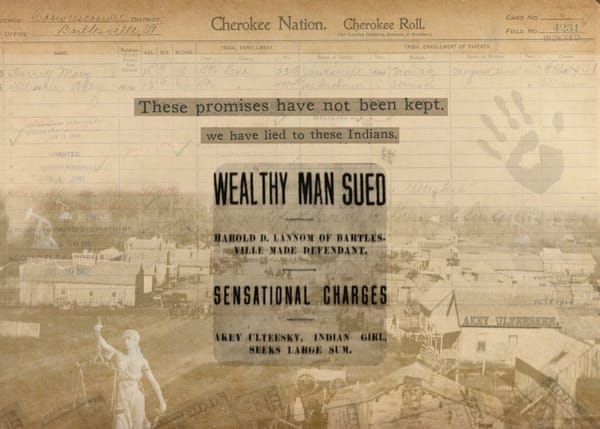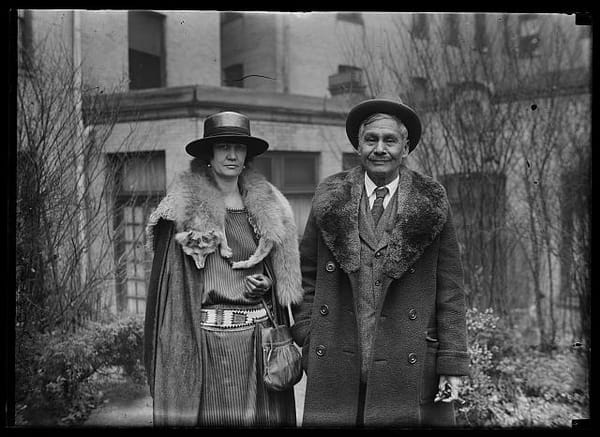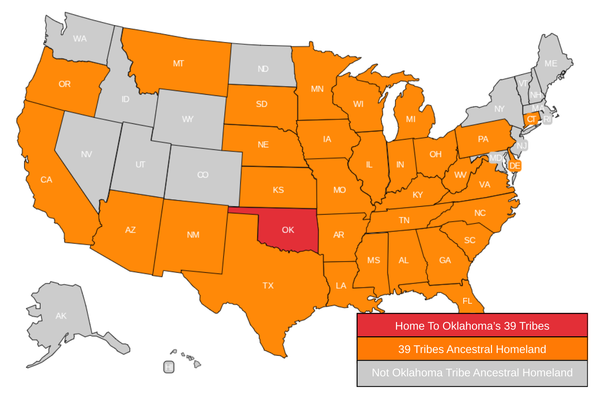Enbridge highlights Indigenous community investment, talks pipeline safety

(CUSHING, Okla.) Indigenous reconciliation was front and center during a tour day Enbridge held with dozens of Tribal business leaders and professionals at their Cushing facility on October 8.
Enbridge executives spoke with dozens of attendees from across the country about the company’s goals for continuing to work with Native communities over the next few years.
Based in Canada, Enbridge is one of the biggest energy transport companies in North America. The company reports they consult and engage with more than 300 Indigenous groups in Canada and the United States.
“We span treaty and tribal lands,” said Andrea Grover, Enbridge Vice President of Stakeholder and Indigenous Engagement. “And we want to acknowledge the fact that that is not our original land and that we are now there and that we're sharing that land and you're having to share with us.”
Their acknowledgement also extends to lack of inclusion in historic transport activities and a commitment to listening and learning from the lived experiences of Indigenous people followed by inclusive actions.
Some of the Oklahoma tribes in attendance at the October gathering included the Sac and Fox Nation, on whose land the Cushing terminal is located, as well as the Pawnee Nation and the Osage Nation. Tribes from Michigan, Montana, and Minnesota were in attendance, as well.
Enbridge highlighted a recent refresh of their Indigenous Reconciliation Action Plan (IRAP) ahead of the tour of their facilities, including their commitment to invest millions of dollars into the communities where they have projects.
In Pillar 2 of the IRAP Refresh, Enbridge stated, “Our aim is to make sure there is at least C$ 80 million (US $57 million) cumulatively over 2022 – 2027 of overall community spend that supports Indigenous communities to enable them to work with Enbridge.”
According to the update, Enbridge invested $29 million in Indigenous communities in the U.S. between 2022 and 2024.
Another priority highlighted by Enbridge: inclusion of Indigenous communities through employment and supply chain partnerships.
Enbridge works with contractors and suppliers that are in the ISNet system. Project managers at Enbridge advocate specifically for tribal contractors. And linemen for the pipelines are not the only roles to fill.
“If they can get in the system, then they can provide gravel,” said Grover. “It could be somebody that is a building cleaning company and they come and clean. If that is a Native-owned company, they could get in the system to be able to do those things. So it's from a very large field potentially down to a very specific smaller scale thing. And any of those companies could be part of this.”
Enbridge has also formed four partnerships with Indigenous nations since 2022.
In 2023, Enbridge worked to help the MHA Nation, also known as the Three Affiliated Tribes, become the owner of a pipeline.
“In June 2023, Enbridge and the MHA Nation announced that Thunder Butte Petroleum Services Inc., a wholly owned MHA Nation subsidiary, would purchase the Plaza/ Wabek Pipeline from Enbridge for C$7 million (US$5 million), making MHA Nation the first Tribal shipper on the Enbridge system,” the IRAP states.
The Athabasca Indigenous Investments Partnership in Alberta took place the same year. When announced, it was the largest energy related Indigenous commercial partnership in the U.S. Through this partnership, Indigenous communities received 11.57% interest in seven Enbridge operated pipelines in northern Alberta, totaling $800 million.
Other deals include five Indigenous communities on the path to co-owning the Wabamun Carbon Hub, six first nation and Metis communities partnering with Seven Stars Energy (Saskatchewan) for a wind project and 36 Indigenous Nations in British Columbia partnering with Enbridge earlier this year to have an ownership position in the Westcoast Natural Gas System.
Safety was also top of mind at the Cushing terminal tour, with a highly engaged question and answer session that touched on everything from pipeline care to line size and transport routes. Protocols discussed included 24/7 monitoring, sensors, robotic Smart PIGs (Pipeline Inspection Gauges) and aerial surveillance.
This year marked the 15th anniversary of the oil spill that took place in Marshall, Michigan. In the years since, Enbridge has focused on restoring the affected area by removing pollution, replanting native plants, and supporting the return of wildlife. Representatives said Enbridge took a lot of lessons away from what happened in Marshall, such as how the pipeline operates, how Enbridge interacts with the community, and other processes.
Executives from Enbridge visited the site in Marshall as part of a recent leadership retreat, participating in ongoing reconciliation work facilitated by Seventh Legacy.
“We were able to do a large sharing circle, a pipe ceremony, we did a tour, and just a lot of really good listening,” said Grover. “And I can tell you, in talking with some of those board members after the fact, their hearts were broken and full all at the same time. They just felt that that was probably one of the most important things that they have ever done in their leadership world.”
Enbridge is a Winds of Change Executive Benefactor of Crosswinds News. Through this benefactor program, Enbridge provides financial support to help sustain Indigenous-led journalism and storytelling. However, Crosswinds News maintains full editorial independence, and this article was produced in alignment with our commitment to fair, accurate, and culturally responsible reporting. For more information about the Winds of Change Benefactor Program, click here.






